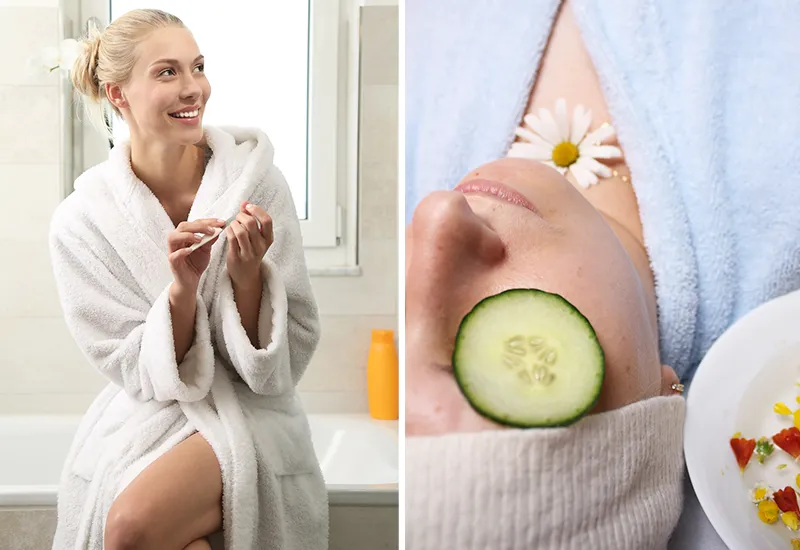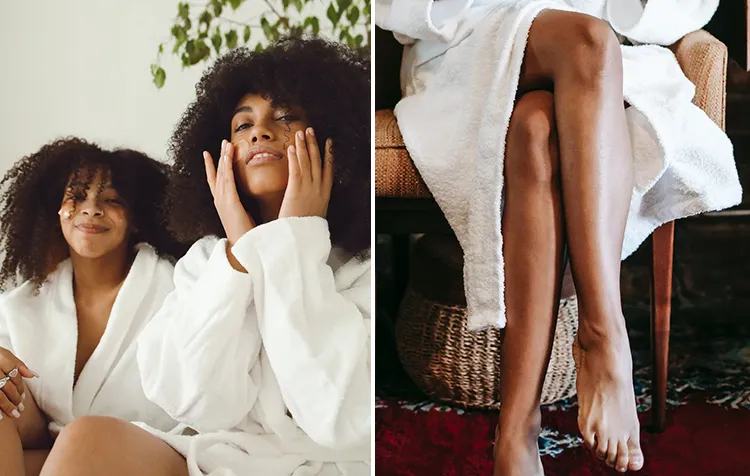Is there actually a sustainable bathrobe? And how can you recognize it? When buying robes and bathrobes, we mostly look at the design, quality and feel. Pretty, durable and cuddly they should be. Whether it was produced in an environmentally friendly or fair way is often secondary in the decision.
In doing so, there are some totally simple tips to identify meaningful alternatives and make a real difference for our planet and other people.
In this article, I would like to show you what makes a bathrobe as sustainable as possible and how you can make sure that you enjoy it for as long as possible. Let's go!
Advantages: Why should you prefer sustainable bathrobes and where can you find them?
Each person has his own ecological footprint. It provides information on the extent to which the natural resources of our planet are used for our personal lifestyle. Our consumer behavior and not least the purchase of our clothing also play a major role in this sustainability indicator.
Living as sustainably as possible is our duty - from Respect opposite the earth, from Solidarity towards other people and from Empathy towards all sentient beings that share the planet with us. And our Responsibility, of course, does not end with the purchase of a bathrobe.
But what actually is a sustainable or environmentally friendly bathrobe? In the trade there are actually more and more alternatives to conventional offers. Whether in specialty stores or online stores - whether light robes and kimonos or the classic Bathrobe for women, men and children.
I would now like to show you exactly how you can recognize the corresponding coats. In addition, you will get some tips for a sustainable use of it.
10 tips: What distinguishes a sustainable bathrobe?

With every purchase you should consider the Always question the product of desire. Do you really need it? What is it made of? Where does it come from?
As with other items of clothing, the sustainability of bathrobes depends primarily on the Materials off. Also the Manufacturing conditions, the Packing, the right Care and many other aspects play an important role.
Below I have compiled my best tips for you. Use them to learn, What makes a bathrobe sustainable and environmentally friendly - and to always know what you should look for when making a purchase.
1. seal OEKO-TEX® Standard 100 and Global Organic Textile Standard (GOTS)
Environmentally friendly bathrobes have the Standard 100 OEKO-TEX® test seal. The world famous label checks textiles for hazardous ingredients such as heavy metals, harmful dyes or Pesticidesthat are bad for nature and our health. The tests are subject to strict criteria and are carried out regularly by independent inspectors.
It's also worth keeping an eye out for the Global Organic Textile Standard, or GOTS, label when buying a bathrobe or robe. This is the world's leading textile processing standard for organic fibers. GOTS includes social and ecological criteria in the production of textiles.
The transparent and independent certification process covers the entire textile supply chain and is considered to be one of the most important Recognition features sustainable fashion.
2. natural materials
In the manufacture of truly sustainable bathrobes come biologically produced and natural, durable materials without animal components for use. For example, cotton, linen or hemp. Fortunately, this does not make the coat less cuddly, colorfast, absorbent and high quality.
You should rather avoid synthetic fibersThe extraction and production of the plastic is harmful to the climate, and the subsequent washing cycle in the washing machine also produces Microplastics dissolved in the sewage system and eventually even into the oceans. into our food chain arrived.
3. resource-saving production
The waste of valuable raw materials contributes massively to the biggest environmental problems of today with. It already starts with the production of textiles such as bathrobes. To ensure that they are as environmentally compatible as possible, they should be produced in the most resource-efficient way possible.
Thereby especially the following aspects important:
- the use of rapidly renewable raw materials,
- low water and energy consumption, and
- short transport and delivery routes
Some companies have already taken appropriate measures and use, for example, the energy of their own photovoltaic solar plant or exclusively recycled material for the manufacture of their products.
Tip: How you generally conserve resources in everyday life I'll be happy to explain how you can do this in the separate, linked blog article.
4. regional manufacturing
If you're big on sustainability, you should opt for a locally made bathrobe where the entire Supply chain as short as possible is. This refers both to the production of the basic materials and to the manufacture of the subsequent bathrobe.
At the same time you support the local economy. In addition, there are no long transport routes, which means that climate-damaging Carbon dioxide emissions can be saved.
Tip: Trials Avoid returns in a targeted mannerFor example, by reading the information about the size of the bathrobe so that it fits you perfectly. Because if you have to send the package back, the CO2 emissions for the shipment were absolutely free.
5. environmentally friendly packaging
Everything we order on the Internet is delivered to us well packaged. Fortunately, many manufacturers and stores are now doing away with plastic packaging and instead use FSC certified paper, which comes from forests managed according to ecological and social criteria.
After you have received your bathrobe, you can use the paper, for example use as wrapping paper and the box for a separate shipment. And how you reuse old packaging in general super I'll be happy to explain how you can do this in the linked blog article.
Tip: Many online stores now also send their parcels climate-neutrally and of course state this information on their website. This is another way of recognizing environmentally friendly products in general.
6. good working conditions and fair wages
Bathrobes can be not only environmentally friendly, but also fair - namely Fairly produced! Many environmentally conscious fashion houses or even sustainable online stores now work exclusively with companies that offer their employees good working conditions and fair wages.
They also commit to special agreements to Respect for human rights and the promotion of social justice. You can recognize fair bathrobes by the fair trade seal - and the respective suppliers by the statements on their website.
Tip: What you can do personally against child labor I'll be happy to show you in a separate article on the blog.
7. recycling and upcycling
In fact, recycled bathrobes have established a new trend. The robes consist made from recycled polyesterfor which, for example, the material of old packaging, bottles or fishing nets was recycled.
Conversely, there are also more and more creative minds that turn old, unusable bathrobes into still Bath mats, wipes or practical armchair bags make
8. second hand bathrobes
Lower resource consumption, lower cost, more appreciation, more individuality, more statement. - the Second hand purchase has many advantages! It does not always have to be something new. Many garments, including bathrobes, which have already been worn once, are still in excellent condition and deserve a second chance.
You can't get a bathrobe more sustainable or cheaper. Just take a look at Clothing swap meets, in Second-hand stores or on the Flea market um.
9. less washing and good care
Even a sustainable robe or bathrobe needs to be washed every now and then to make it as durable as possible. But beware: Washing too often is not good for the environment, consumes a lot of water and electricity - and not least harms the tissue of the bathrobe. Reduce the number of washes to the minimum necessary.
It is also best to use organic detergent that does not contain dyes, enzymes, surfactants, optical brighteners and artificial fragrances. The ideal detergents for your bathrobe have natural ingredients and are available in powder form or as a liquid detergent in the recycled package.
10. all-in-one bathrobe
In the meantime, there is a wide range of bathrobes in various designs - from robes to sauna bathrobes and kimono. But do you really need several models at home? No way!
Better get some space in your sustainable closetby looking at ONE versatile bathrobe that is suitable for all purposes. This is a minimalist approach that saves you not only space, but also money - and is usually quite enough.
Buy sustainable bathrobes? No problem!

You would like to get your Making life more sustainable? Then you should start already with the purchase of your bathrobe and take to heart the tips and tricks mentioned above. Above all, make sure that it is durable, made of natural materials and manufactured under fair conditions. Do not wash it too often, but always handle it with care.
And in general, don't be afraid to ask the respective manufacturer or salesperson - because that's how positive change happens.
"Be yourself the change you wish to see in this world."
Mahatma Gandhi (more at Environmental protection quotes)
I really hope that I could help you with this article. Do you have any questions, suggestions or further tips for the most environmentally friendly bathrobes possible? Then I look forward to your comment!
Stay sustainable,

PS: I also talked about animal-free, vegan bathrobes in this article. Why this product feature is so important, I'll gladly explain to you next in the article about the Animal suffering in the textile industry.





